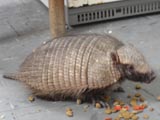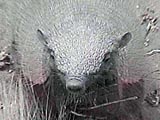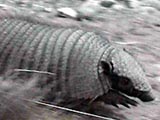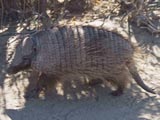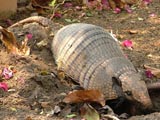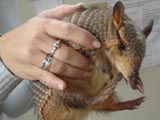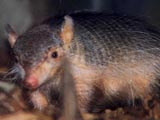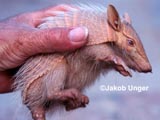Hairy armadillos
Three species of hairy armadillos are recognized: The Andean hairy armadillo (C. nationi), the hairy armadillo (C. villosus), and the little hairy armadillo (C. vellerosus).
Chaetophractus nationi
Andean Hairy Armadillo
- Range:
Bolivia, northern Chile.
- Size and Weight:
Head and body length: 220 — 400 mm (8.7 — 15.7 in).
Tail length: 90 — 175 mm (3.5 — 6.9 in).
Weight: Unspecified.- Description:
The banded portion of the carapace has 18 bands, of which 7 or 8 are moveable. All members of the genus Chaetophractus have more hair than most armadillos. The hair projects from the scales of the armor and the underside of the body and limbs are covered by whitish or light brown hairs.
- Habitat:
C. nationi lives exclusively in open high-altitude grasslands.
- Ecology:
Mainly nocturnal in summer to avoid heat, and diurnal in winter. Reported home range is about 3.4 ha (8.4 acres). All members of the genus Chaetophractus live in burrows, and try to dig burrows as an escape mechanism.
All members of the genus Chaetophractus burrow under carcasses to obtain maggots and other insects, and have been reported to burrow directly into carcasses at times. They occasionally dig up insects by forcing their head directly into ground a few centimeters. Some individuals have been seen killing small snakes by jumping on them, using the edge of the shell to cut them. Hunted as an agricultural pest and for food. C. nationi is listed by the IUCN as vulnerable, and is listed on appendix 2 of the CITES.
- Biology:
The gestation time is 2 months, and there may be multiple litters per year. Generally two young are produced, usually 1 male and 1 female. The young open their eyes at 16 — 30 days, are weaned at 50 — 60 days, and reach sexual maturity at 9 months.
- Pictures:
-
I do not currently have a photograph of C. nationi on this website. ARKive | Images of Life on Earth has two pictures of an Andean hairy armadillo, with a biographical account of this species.
Do you have a picture of C. nationi that you would like to donate to this site? Please see the Armadillos Wanted page to see how you can help.
Chaetophractus villosus
Hairy Armadillo
- Range:
Northern Paraguay and probably southern Bolivia to central Argentina.
- Size and Weight:
Head and body length: 220 — 400 mm (8.7 — 15.7 in).
Tail length: 90 — 175 mm (3.5 — 6.9 in).
Average weight: 2.02 kg (4.5 lbs).- Description:
The banded portion of the carapace has 18 bands, of which 7 or 8 are moveable. All members of the genus Chaetophractus have more hair than most armadillos. The hair projects from the scales of the armor and the underside of the body and limbs are covered by whitish or light brown hairs.
- Habitat:
Open areas; often found in semi—desert locations.
- Ecology:
Mainly nocturnal in summer to avoid heat, and diurnal in winter. Reported home range is about 3.4 ha (8.4 acres). All members of the genus Chaetophractus live in burrows, and try to dig burrows as an escape mechanism. If unable to dig, C. villosus draws in its feet and flattens its body against the ground so that only the shell is exposed. This is an effective defense against canid or avian predators. Emits a snarling noise when pursued. The animal anchors itself in its burrow by flexing its body so that the shell edges dig into dirt.
All members of the genus Chaetophractus burrow under carcasses to obtain maggots and other insects, and have been reported to burrow directly into carcasses at times. They occasionally dig up insects by forcing their head directly into ground a few centimeters. Some individuals have been seen killing small snakes by jumping on them, using the edge of the shell to cut them. Hunted as an agricultural pest and for food.
- Biology:
C. villosus breeds in September. The gestation time is 2 months, and there may be multiple litters per year. Generally two young are produced, usually 1 male and 1 female. The young open their eyes at 16 — 30 days, are weaned at 50 — 60 days, and reach sexual maturity at 9 months. One C. villosus specimen lived more than 30 years in captivity. C. villosus is the second most common armadillo held in zoos.
- Pictures:
-
Do you have a picture of C. villosus that you would like to donate to this site? Please see the Armadillos Wanted page to see how you can help.
Chaetophractus vellerosus
Little Hairy Armadillo or Screaming Hairy Armadillo
- Range:
Western Bolivia to Paraguay and central Argentina.
- Size and Weight:
Head and body length: 220 — 400 mm (8.7 — 15.7 in).
Tail length: 90 — 175 mm (3.5 — 6.9 in).
Average weight: 0.84 kg (1.9 lbs).- Description:
The banded portion of the carapace has 18 bands, of which 7 or 8 are moveable. All members of the genus Chaetophractus have more hair than most armadillos. The hair projects from the scales of the armor and the underside of the body and limbs are covered by whitish or light brown hairs.
- Habitat:
Open areas; often found in semi—desert locations.
- Ecology:
C. vellerosus prefers to burrow in sloping sand dunes, digging burrows several meters long and more than a meter deep. Mainly nocturnal in summer to avoid heat, and diurnal in winter. Reported home range is about 3.4 ha (8.4 acres). All members of the genus Chaetophractus live in burrows, and try to dig burrows as an escape mechanism.
All members of the genus Chaetophractus burrow under carcasses to obtain maggots and other insects, and have been reported to burrow directly into carcasses at times. They occasionally dig up insects by forcing their head directly into ground a few centimeters. Some individuals have been seen killing small snakes by jumping on them, using the edge of the shell to cut them. C. vellerosus is omnivorous. Over half of its food intake in winter is vegetation. In summer it eats many rodents, lizards and other small vertebrates. Hunted as an agricultural pest and for food. Sometimes called the screaming hairy armadillo due to the squealing noises it emits when threatened.
- Biology:
The gestation time is 2 months, and there may be multiple litters per year. Generally two young are produced, usually 1 male and 1 female. The young open their eyes at 16 — 30 days, are weaned at 50 — 60 days, and reach sexual maturity at 9 months.
- Pictures:
-
Do you have a picture of C. vellerosus that you would like to donate to this site? Please see the Armadillos Wanted page to see how you can help.
Sources
Nowak, R.M. 1999. Walker’s Mammals of the World, 6th edition. Johns Hopkins University Press, Baltimore, MD. 158-168.
Abbreviations
IUCN: International Union for Conservation of Nature and Natural Resources
USDI: United States Department of the Interior
CITES: Convention on International Trade in Endangered Species of Wild Fauna and Flora
 ] will leave this website.
] will leave this website.

